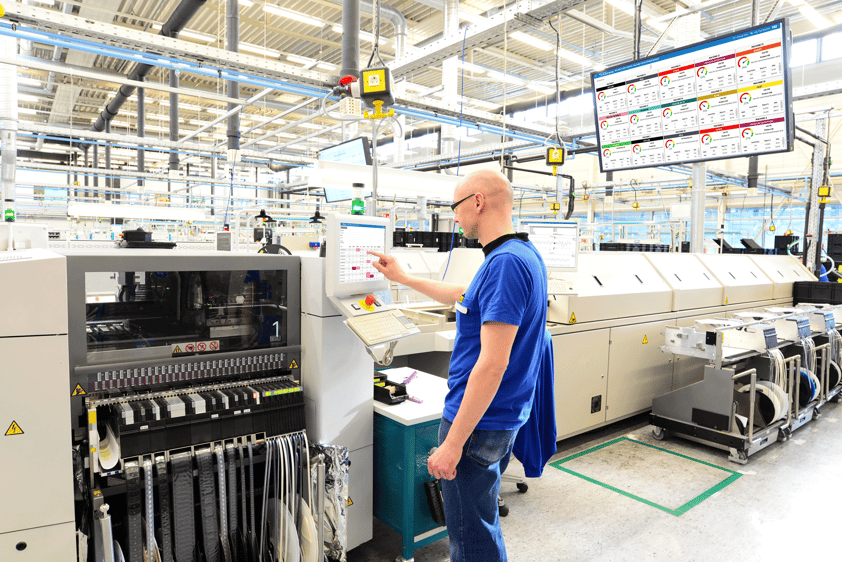PlantStar BLOG
Intelligent MES Software Aids Labor Shortage
Oct 21, 2021 5:30:00 PM / by David Crowley

The pandemic exacerbated a labor deficit that manufacturers have been facing, so being as productive as possible has become even more vital nowadays. Modern Manufacturing Execution System (MES) ameliorate employment shortfalls by streamlining the manufacturing process, providing real-time visibility into what’s happening during a production run, enabling proactive production scheduling, and delivering flexible online training.
The manufacturing industry has been a vital part of the US economy for decades, but its worker demographics have been shifting and creating a gap between what is needed on the shop floor and what is available. Because of its long standing vibrance, older employees have been retiring in growing numbers and not being replaced. Deloitte and The Manufacturing Institute expect the US manufacturing worker shortage during the next decade to reach its highest levels ever recorded, more than earlier estimates of 2 million unfilled jobs during 2015–2025.
A Skills Shortage Emerges
Another challenge is the production process continues to evolve, so workers need new skills. Suppliers are turning to technology to streamline processes, improve productivity, and enhance the flow of goods through the supply chain. Technology advances have been replacing many of the repetitive manual tasks done on the assembly line. Therefore, tools, such as collaboration platforms, work-based social media, and instant messaging play increasingly larger roles in the manufacturing process. New jobs emerge, but they often require soft skills, such as critical thinking, creativity, and technical expertise.
Many workers lack such skills. Manufacturing companies increasingly rely on inexperienced and temporary workers who need job guidance and training to become productive. Yet, suppliers in some cases take a decidedly Old School approach to building their staff’s skills. In a number of cases, they do not offer the training programs for workers because they are not in their area of expertise, or they do not know how to cost justify such investments.
Without proper training, many workers struggle to keep up with the rapid pace of technology change, leading to job stress, lower productivity, and turnover. In fact, proper training is one of three key factors in attracting and retaining employees.
MES Capabilities Streamline Manufacturing Processes
New MES systems are emerging and breaking down traditional information and communication barriers, so manufacturers enhance their operations, boost productivity, and do more with less. The solutions are user friendly. Rather than paper and pencil or spreadsheets filled with large columns of numbers, they present workflow performance via mobile touchscreens that highlight important information.
These systems provide access to real-time production plan and process information. Consequently, managers more easily follow jobs as they move from scheduling through production to fulfillment. They see critical parameters, such as total parts created, production time, downtime, rejects, and parts remaining to be produced. They create statistical process control (SPC) charts and graphs that identify any potential anomalies, so they are addressed ASAP.
The solutions integrate with back office Enterprise Resource Planning solutions, so managers have an end-to-end view of their supply chain. As a result, manufacturers transform their plants into smart factories that improve manufacturing operations, reduce their operational costs, and maximize Overall Equipment Effectiveness (OEE).
Executives gain real time data access to shop floor performance and perform tasks, such as operator tracking and labeling and barcoding performance. Therefore, staffing decisions are made more quickly and more intelligently, and therefore become more effective. The new tools streamline a number of traditionally tedious tasks: onboarding suppliers; distributing work across the factory floor; outlining instructions; improving production scheduling; defining quality and compliance specs; and managing logistics. In addition, automated job scheduling reduces labor needs.
Also, MES reduces downtime by keeping even the most bare-bones team informed with actionable data and pattern recognition using real-time machine data collection and deeper downtime/scrap reporting. In essence, MES deployments enable managers overseeing the manufacturing process to maximize staff performance.
Extend Training Options
The new tools also help close the training gap. One change has been a shift from live to online training, which offers convenience. Employees access e-learning modules via desktop, laptop, or smart devices. Trainers no longer have to travel to hold classes, so more are held. With virtual reality and augmented reality tools, employers offer virtual walk-throughs and task simulations, so employees have a practical rather than theoretical understanding of their tasks. Employees gain the skills needed to be successful now and in the coming years.
Manufacturers face a significant personnel challenge, which has been becoming worse. New MES systems provide simple access to production run information, streamlining business processes and maximizing productivity. They also support new training modalities to ensure that workers have needed skills. As a result, suppliers are adopting these tools in growing numbers as they try to mitigate the ongoing personnel shortage.
Topics: mes software
Subscribe to Email Updates
Posts by Topic
- Manufacturing Execution Systems (38)
- manufacturing solutions (16)
- MES 101 (13)
- Industry 4.0 (11)
- improve efficiency (10)
- Plastic Molding (9)
- Plastics Technology (9)
- mes software (9)
- mes solutions (9)
- MES hardware (8)
- Shop Floor Production (8)
- digital transformation (7)
- Reduce scrap (6)
- data-driven-decisions (6)
- Medical molding (5)
- lean manufacturing (5)
- process monitoring (5)
- product quality (5)
- lights-out manufacturing (4)
- manufacturing dashboard (4)
- production monitoring (4)
- ERP integration (3)
- Shop Floor Safety (3)
- supply chain management (3)
- Injection Molding Technology (2)
- defect collection (2)
- machine mes (2)
- process variables (2)
- digital strategy (1)
- labor gap (1)
- throughput (1)


